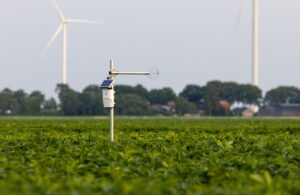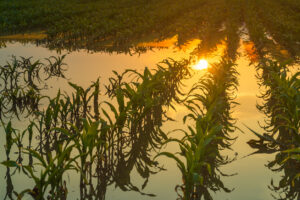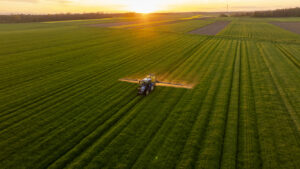Written by Gilly Kinsky, VP Marketing, CropX
When you hear “regenerative agriculture,” what comes to mind? For most, it’s cover crops, no-till systems, crop rotations, or maybe integrating livestock. All of those practices matter, but there’s another lever that doesn’t always get the spotlight: irrigation.
At its heart, regenerative agriculture is about creating the conditions for soil to heal itself and stay resilient. And how a farm irrigates can either work against that mission, or quietly enable it.
Water as a Partner in Soil Health
Healthy soils breathe, absorb, cycle nutrients, and store carbon. But they can only do that if the environment underground is stable enough for microbial life to thrive. That’s where precision irrigation comes in.
Precision irrigation optimizes soil moisture, increasing both soil organic carbon (SOC) and supporting microbial activity, particularly in drier climates and fine-textured soils. According to a systematic meta-analysis published in PMC, irrigated agriculture increased SOC stocks by 5.9%, with greatest improvements seen in surface soils, in finer-textured soils, and under sprinkler irrigation, all of which also promote a vibrant soil microbiome.
Delivering water and nutrients right to the root zone reduces waste, prevents runoff, and helps soils build fertility naturally. And when irrigation systems are buried, they minimize disturbance, preserving soil structure while making it easier to keep cover crops in the rotation.
A study in Nature’s Scientific Reports found that precision irrigation thresholds affected soil organic carbon decomposition rates, with excess water in early vegetative growth periods accelerating labile SOC breakdown. This finding shows that water management not only shapes plant health but directly impacts carbon cycling and long-term soil fertility. Researchers recommend context-sensitive irrigation thresholds to optimize SOC sequestration.
In other words: water isn’t just “keeping plants alive.” It’s shaping the conditions for regeneration below the surface.
Building Resilience Above Ground
For farmers, resilience is everything. Flood one year, drought the next, it’s a familiar cycle. Soil that can hold water in dry times and absorb it in wet times make the difference between surviving and thriving.
By reducing erosion, stabilizing soil, and keeping nutrients in place, precision irrigation contributes directly to that resilience. It helps cover crops establish stronger root systems. It makes agroforestry or intercropping more manageable. And it reduces withdrawals from rivers and aquifers, protecting watershed health for everyone downstream.
Recent reviews in Frontiers in Sustainable Food Systems argue that improved soils retain more rainfall and lower the need for irrigation inputs, demonstrating quantitatively that every incremental gain in soil water-holding capacity translates to reduced irrigation water use, even in water-stressed regions. However, authors caution that actively managing soil moisture for regeneration requires careful water accounting, especially where catchment-level water allocations are tight. They note that additional water for soil regeneration could strain resources and must be balanced with broader watershed needs.
The outcome isn’t just healthier soils, it’s more reliable yields, even when weather doesn’t cooperate. Many studies show that precision irrigation improves crop yields significantly by maintaining optimal moisture levels precisely when and where crops need it. For instance, In Illinois, a CropX-managed corn field produced 22% more grain with zero stress events, while the neighboring grower-managed field underperformed. Across hundreds of sugarcane fields worldwide, CropX irrigation management delivered an average 70% yield increase. These results show how precision irrigation transforms underperforming fields into consistent producers, making agriculture more resilient to stress and variability. These results show how precision irrigation transforms underperforming fields into consistent producers, making agriculture more resilient to stress and variability. These yield gains translate into agricultural systems that can better withstand unpredictable weather, making food production more reliable in the face of climate variability.
Why It Matters Beyond the Farm
Dealers and agribusinesses are just as tied to soil resilience as growers are. Dealers need solutions that genuinely support their customers’ long-term success. Food companies are under pressure to meet regenerative sourcing goals, often across millions of acres.
Irrigation connects the dots. The same practices that help farmers cut costs and stabilize production also generate measurable outcomes that corporations and policymakers care about, carbon sequestration, reduced nutrient runoff, healthier watersheds. It’s one of those rare tools that create value across the entire chain, from soil microbes all the way to global sustainability targets.
A Shift in Perspective
The conversation about regenerative agriculture has grown louder in recent years, and that’s a good thing. But as we celebrate cover crops and no-till systems, it’s worth asking what else makes those practices possible.
Research urges site-specific assessment and adaptive management of irrigation practices. Effects on SOC storage can be inconsistent, influenced by soil chemistry (such as carbonates in calcareous soils), water table dynamics, and crop type. Long-term studies show that blanket approaches are unlikely to succeed; instead, integrated water-and-soil management must be matched to local conditions for regenerative outcomes.
Irrigation may not always be the headline, but it can be the foundation. By managing water with precision, we give soils, crops, and communities a chance to regenerate, not just endure.




